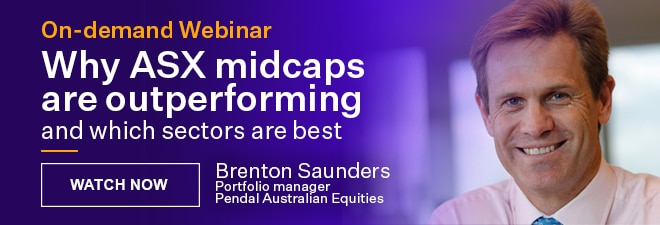
Mainstream Online Web Portal
LoginInvestors can view their accounts online via a secure web portal. After registering, you can access your account balances, periodical statements, tax statements, transaction histories and distribution statements / details.
Advisers will also have access to view their clients’ accounts online via the secure web portal.
Brenton Saunders: Why ASX midcaps are outperforming
Midcaps are not just a diversification opportunity – right now, they are also outperforming their larger cap counterparts. BRENTON SAUNDERS explains why – and where to look.
- Higher earnings growth driving performance
- Diversification benefits
- Find out more about the Pendal MidCap fund
MIDCAP stocks are a sweet spot in the Australian share market, delivering higher earnings growth and outperforming their large cap peers over time, says Pendal’s Brenton Saunders.
Narrow market leadership in recent years has left many index investors increasingly concentrated in mature, slower-growing sectors like the big banks.
Saunders says midcaps can offer a more balanced alternative with better exposure to faster-growing businesses and a higher level of corporate activity that can help to underpin valuations.
“If somebody asked you at a barbecue, why do midcaps outperform the large cap indices, quite simply it’s because they have higher earnings growth,” says Saunders, portfolio manager of the Pendal MidCap Fund.
“They’re typically companies in the sweet spot of their corporate development and their evolution as businesses.
“They’re big enough to attract real investment attention – both from investors and bigger corporates – but unlike many smaller cap companies they’re pretty settled in terms of their balance sheets and funding.
Saunders was speaking at the Pendal webinar Why ASX midcaps are out-performing – and which sectors are best-positioned.
What makes an attractive midcap?
Different investors can have different views on what makes a midcap company.
For Pendal, the segment includes stocks ranked 51 to 150 on the ASX – a wider definition than the ASX MidCap index.
Saunders says those 100 companies have a lower concentration in slower-growth sectors compared to the broader market, with no single industry dominating performance.
“The spread in midcaps across the economy and sectors on the ASX is just much better,” says Saunders.
“The sector historically has empirically done better than most of the other larger and small cap aggregates on the ASX.
“And despite that, it acts as a very powerful portfolio diversifier.”
Top 10 midcaps include companies like Lynas Rare Earths, Life360, JB Hi-Fi, ALQ, and REA Group, offering exposure to diverse growth themes rather than concentration in banks and large-cap resource stocks.
Why midcaps look appealing now
Saunders says recent conditions have shifted the balance in favour of midcaps after a multi-year period of trading in a range as investors chased large-cap bank stocks instead.
Corporate activity has picked up, with several companies under offer or recently acquired.
“In my portfolio, I’m usually dealing with two or three of them that are under offer,” says Saunders.
“That just serves to underpin ratings and the price discovery.”
A lower interest rate environment is also aiding rate-sensitive parts of the investment universe such as real estate, while easing real rates are typically supportive for the gold price.
“There are good opportunities in mid-caps now – there are a number of companies and sectors on the ASX with strong outlooks.
“It’s well positioned to carry on outperforming, which it has done for the past year and a half.”
Diversification benefits
Saunders says the midcap sector’s breadth is a core part of its appeal.
Businesses in industries as diverse as software, data centres, gold, energy, consumer goods and medical technology are all offering attractive opportunities.
The diversity makes the segment much less concentrated than the broader market.
The biggest 10 companies in the 51-150 represent just over a fifth of the index, with no single sector dominating.
That compares to a 45.6 per cent weighting for the top 10 in the S&P/ASX 300, where banks alone represent nearly a quarter of the S&P/ASX 300.
Saunders names diversified financials as a particularly interesting opportunity, with platform businesses like Netwealth and Hub24 benefiting from growing demand for more sophisticated wealth-management functionality.
He says retirement is another area he is watching closely, driven by government efforts to improve retirement income products. This is creating opportunities for companies like Challenger and AMP as the population ages.
About Brenton Saunders and Pendal MidCap Fund
Brenton is a portfolio manager with Pendal’s Australian equities team. He manages Pendal MidCap Fund, drawing on more than 25 years of expertise. He is a member of the CFA Institute.
Pendal MidCap Fund features 40-60 Australian midcap shares. The fund leverages insights and experience gained from Pendal’s access to senior executives and directors at ASX-listed companies. Pendal operates one of Australia’s biggest Aussie equities teams under the experienced leadership of Crispin Murray.
Pendal is a global investment management business focused on delivering superior investment returns for our clients through active management.

